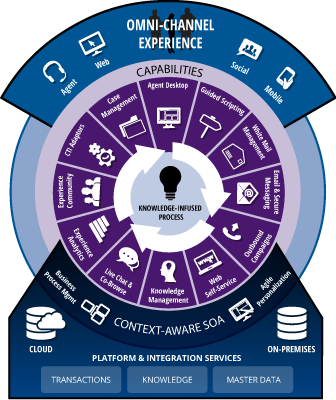In an age of convenience and data collection, buzzwords like “omnichannel” aren’t going anywhere anytime soon. In fact, according to VendHQ, the opportunity cost of not being an omnichannel brand is 10% in lost revenue.
For some retailers, omnichannel is associated with a successful campaign of aligning all of their channels to create a consistent experience, while other retailers are still struggling to adapt to the new world of omnichannel retailing. Unfortunately, a survey taken by Periscope found that 78% of brands admit there is no one brand experience across their channels, but 64% acknowledge that “a well defined cross or multi-channel strategy” is the top innovation that would drive digital growth.
This graphic by Kana gives a complete overview of what a complete omnichannel experience should include:

A successful omnichannel strategy should consist of a strategic plan to align the customer experience across multiple platforms and channels. With the stats above in mind, you should be working towards creating a working omnichannel strategy.
If you are in need of some inspiration from companies who have already implemented perfect omnichannel user experiences, here are three of our favorite examples:
REI
With so many customers showrooming for current prices and product availability, even while they are currently in a store, REI used an omnichannel strategy that combines the process so there is never confusion on in-stock products or even price. Now, all of REI’s shopping channels work instantaneously so the most up-to-date and accurate product information can be available to their customers no matter what channel they are shopping through. In order to support their omnichannel initiative, REI has equipped their stores with Wi-Fi access and provided associates with mobile devices in order to assist customers looking for product information.
REI has also gone above and beyond their omnichannel initiatives by creating a community around their brand. Customers know they can always count on the high quality gear available at REI stores, and they also have access to take courses from industry professionals, including cross country, skiing, and rock climbing pros.
Tommy Hilfiger
As online shopping has continued to grow in popularity over the years, Tommy Hilfiger wanted to make sure that their customers could receive the same pricing no matter what channel they were using. In the past, Tommy customers were only able to receive exclusive pricing such as discounts for teachers, military, and students in stores. By expanding their omnichannel capabilities with eligibility verification, Tommy is able to offer exclusive pricing on any platform, and know that only eligible customers have access. Within just three months, the promotions that Tommy brought online accounted for 10% of their total site sales.
Tommy Hilfiger also recently launched a new line of clothing with supermodel Gigi Hadid. With this launch, they created a new user experience for any customer shopping the line. Customers who have questions about the line can easily message Tommy Hilfiger within the Facebook messaging system and receive a response within minutes. Tommy Hilfiger himself commented on their new customer communication tool and said, “We are obviously distributed in our own stores and in department stores, but going directly to the consumer is really part of the motive and the future of the omni-channel process.”
Disney
>Booking a trip can be stressful, especially if you are only able to use a mobile device, but that’s not the case when booking with Disney. Disney’s trip-planning website works equally as well on computers, tablets, and mobile devices. And the best part is that once you have booked your trip, the “My Disney Experience” tool can help you plan your entire trip. You have access to plan activities for every day you are visiting the Disney locations, including your hotel, FastPass selections, dining reservations, reminder notes, and even up-to-date information about what’s going on around the parks during your stay and real-time attraction wait times.
The omnichannel experience doesn’t stop with their booking process either. Once you have checked into a Disney Hotel, their Magic Band Program acts as a hotel room key, photo storage device for any photos taken of you with Disney characters, a food ordering tool, and a FastPass integration. It’s all a single process making it simple and easy for Disney patrons to enjoy their stay.
REI, Tommy Hilfiger, and Disney have all set the bar high for their competitors in creating a successful omnichannel experience. How do you stack up?







